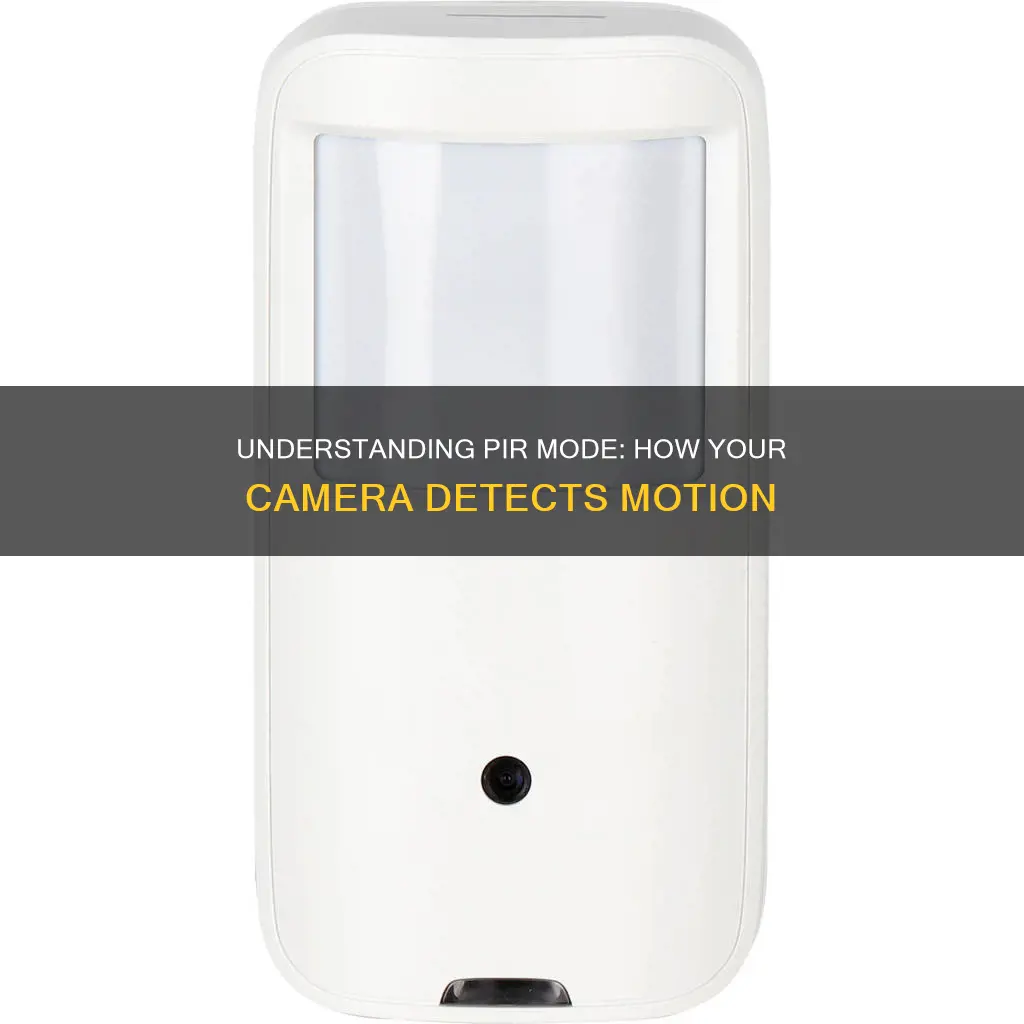
PIR stands for Passive Infrared. PIR mode on a camera refers to its motion detection system, which uses infrared sensors to detect changes in temperature caused by movement. When an object, animal, or person moves within the camera's detection range, the PIR sensor detects the change in temperature and triggers the camera to take a photo or record a video. This mode is commonly used to conserve battery life by only activating the camera when there is movement in the area.
| Characteristics | Values |
|---|---|
| Full Form | Passive Infrared |
| Function | Motion detection |
| Working | Detects changes in temperature caused by movement |
| Activation | When an animal or person moves within the camera's detection range |
| Use Case | Conserves battery life by only activating the camera when there is movement in the area |
| Other Use Cases | Capturing images of wildlife, hunting, wildlife observation, security purposes |
| Advantage | Reduces the number of false triggers caused by wind, leaves, or other non-living objects |
| Adjustable | PIR sensitivity settings, detection range |
| Time-lapse Mode | Takes photos at set intervals regardless of motion detection |
| Hybrid Mode | Combines time-lapse and motion detection to capture more photos and videos |
| PIR Cameras | Avoid security system false alarms, get real-time notifications and email motion snapshots when motion events occur |
| PIR Camera Placement | Outdoor vs indoor |
| PIR Camera Storage | SD card (slot) or cloud storage |
What You'll Learn

PIR mode conserves battery life
PIR mode is an essential feature for trail cameras, as it allows them to conserve battery life by only activating the camera when motion or a heat signature is detected. This is particularly useful for wildlife photography, as it ensures that the camera is only capturing images when there is activity in the area.
PIR stands for Passive Infrared. The mode uses infrared sensors to detect changes in temperature caused by movement. When an animal or person moves within the camera's detection range, the PIR sensor detects the change in temperature and triggers the camera to take a photo or record a video. This is a popular feature for hunting, wildlife observation, and security purposes.
The PIR mode is also useful for reducing false triggers caused by wind, leaves, or other non-living objects. This not only saves battery life but also ensures that the camera captures relevant images or videos. With PIR mode, trail cameras can record for days instead of hours, making them a valuable tool for monitoring and research.
The latest advancements in PIR technology have improved detection ranges and sensitivity. This allows trail cameras to capture images of animals and humans from greater distances. Adjustable PIR sensitivity settings give users the ability to customise the detection range, further reducing false triggers.
Overall, PIR mode is an effective way to conserve battery life in trail cameras, ensuring efficient use of power and capturing relevant footage when motion or a heat signature is detected.
How to Keep Your WiFi Camera Charged and Ready
You may want to see also

PIR mode reduces false triggers
PIR stands for Passive Infrared. PIR mode on a camera refers to its motion detection system, which uses infrared sensors to detect changes in temperature caused by movement. When an object, animal, or person moves within the camera's detection range, the PIR sensor detects the change in temperature and triggers the camera to take a photo or record a video.
One of the key advantages of PIR mode is its ability to reduce false triggers. PIR technology is based on the principle that all living things emit heat in the form of infrared radiation. By detecting changes in infrared radiation, PIR sensors can differentiate between relevant motion, such as an animal or human, and irrelevant motion caused by wind, leaves, or other non-living objects. This results in fewer false triggers and ensures that the camera only captures images or videos of actual subjects, conserving battery life and storage space.
The sensitivity of PIR sensors can be adjusted to suit specific needs. Higher sensitivity settings can capture more images but may also increase the likelihood of false triggers from minor movements. Advancements in PIR technology have led to improved detection ranges and sensitivity, allowing for more accurate motion detection and heat signature recognition.
To further reduce false triggers, proper placement of the camera is essential. Simple factors like air blowing nearby or small rodents moving across the floor can trigger the sensor. Calibration of the sensor is also important. Users can adjust parameters such as distance and dwell time to optimize the PIR sensor's performance and minimize false triggers.
In summary, PIR mode in cameras reduces false triggers by utilizing passive infrared technology to detect and differentiate relevant motion. With the right settings and placement, PIR mode ensures reliable and accurate motion detection, making it a valuable feature for security systems, wildlife photography, and other applications.
Charger Lost? Here's How to Power Your Camera
You may want to see also

PIR mode is useful for wildlife photography
PIR mode is an incredibly useful feature for wildlife photographers. It allows them to capture images and videos of animals without needing to be physically present at the camera to take the shot. This is particularly useful for photographing nocturnal, shy, or elusive animals, as the camera can be left for days or weeks to capture the perfect shot.
PIR stands for Passive Infrared. It is a motion detection system that uses infrared sensors to detect changes in temperature caused by movement. When an animal or person moves within the camera's detection range, the PIR sensor detects the change in temperature and triggers the camera to take a photo or record a video. This is ideal for wildlife photography, as it means the camera only activates when there is movement in the area, ensuring the photographer doesn't miss a shot.
PIR mode also helps to conserve battery life, as the camera is only activated when motion is detected. This is especially beneficial for wildlife photography, as the camera can be left for extended periods without needing to change the batteries. Additionally, PIR mode reduces the number of false triggers caused by non-living objects, such as wind, leaves, or bugs, which further conserves battery life and ensures the photographer captures only relevant images.
The latest advancements in PIR technology have improved detection ranges and sensitivity, allowing for the capture of high-quality images and videos of wildlife from greater distances. The sensitivity of the PIR sensor can be adjusted to suit the user's needs, with higher sensitivity capturing more images but also increasing the risk of false triggers. This customizability ensures photographers can tailor the settings to their specific requirements, making PIR mode a versatile and powerful tool for wildlife photography.
Overall, PIR mode is an invaluable feature for wildlife photographers. It enables efficient use of battery life, ensures the camera captures images whenever there is activity, and provides high-quality footage of wildlife in their natural habitats. With its advanced motion detection capabilities, PIR mode has become an essential tool for capturing the perfect shot in the challenging and unpredictable world of wildlife photography.
Kodak Camera Battery Exhausted: What's the Fix?
You may want to see also

PIR mode is used for security purposes
PIR mode is commonly used on trail cameras to conserve battery life by only activating the camera when there is movement in the area. This mode is also useful for capturing images of wildlife that may be difficult to spot with the naked eye. PIR technology is based on the principle that all living things emit heat in the form of infrared radiation.
PIR cameras are highly effective in detecting motion and reducing false triggers, as they only detect changes in infrared radiation and not other types of movement such as wind or vegetation. PIR cameras are also often used in security systems to detect movement or intruders by recognising light emitted from nearby objects. PIR sensors can detect general movement, but do not provide information on who or what moved; for that, an imaging IR sensor is required.
PIR-based motion detectors are commonly used in burglar alarms and automatically activated lighting systems. The PIR sensor detects changes in the amount of infrared radiation impinging upon it, which varies depending on the temperature and surface characteristics of the objects in front of it. When an object, such as a person, passes in front of a background, such as a wall, the temperature at that point in the sensor's field of view will rise from room temperature to body temperature, and then back again. This triggers the detection.
PIR cameras are an effective tool for security and motion detection, offering improved accuracy and reliability compared to traditional motion detection technologies.
Low Power Mode: Impact on Camera Performance
You may want to see also

PIR mode is used for hunting
PIR mode is a useful feature for hunters. It allows them to monitor animal activity in a specific area without disturbing the natural behaviour of the wildlife. This is crucial for research and conservation purposes.
PIR stands for Passive Infrared. It is a motion detection system that uses infrared sensors to detect changes in temperature caused by movement. When an animal or person moves within the camera's detection range, the PIR sensor detects the change in temperature and triggers the camera to take a photo or record a video. This is particularly useful for hunting, as it ensures that the camera only captures images when there is activity in the area.
PIR mode helps hunters by conserving battery life. The camera is only activated when motion is detected. This is beneficial for hunters who may be using the camera in remote locations, as it means they don't have to worry about the camera running out of battery while they are away.
The PIR mode is also useful for capturing images of wildlife that may be difficult to spot with the naked eye. The latest advancements in PIR technology have led to improved detection ranges and sensitivity, allowing hunters to capture images of animals from greater distances.
PIR mode can also help hunters avoid false triggers caused by wind, leaves, or other non-living objects. This means that the camera will only capture images or videos of actual animals passing by, saving battery life and memory space.
Overall, PIR mode on a trail camera is a valuable feature for hunters. It enhances the camera's performance and accuracy in capturing images or videos of animals. By understanding how to use PIR mode effectively, hunters can improve their success in monitoring and hunting wildlife.
Camera Battery Drain: Quick Fix Tips
You may want to see also
Frequently asked questions
PIR stands for Passive Infrared.
PIR mode uses infrared sensors to detect changes in temperature caused by movement. When an animal or person moves within the camera's detection range, the PIR sensor detects the change in temperature and triggers the camera to take a photo or record a video.
PIR mode is commonly used to conserve battery life by only activating the camera when there is movement in the area. It also reduces the number of false triggers caused by wind, leaves, or other non-living objects.







